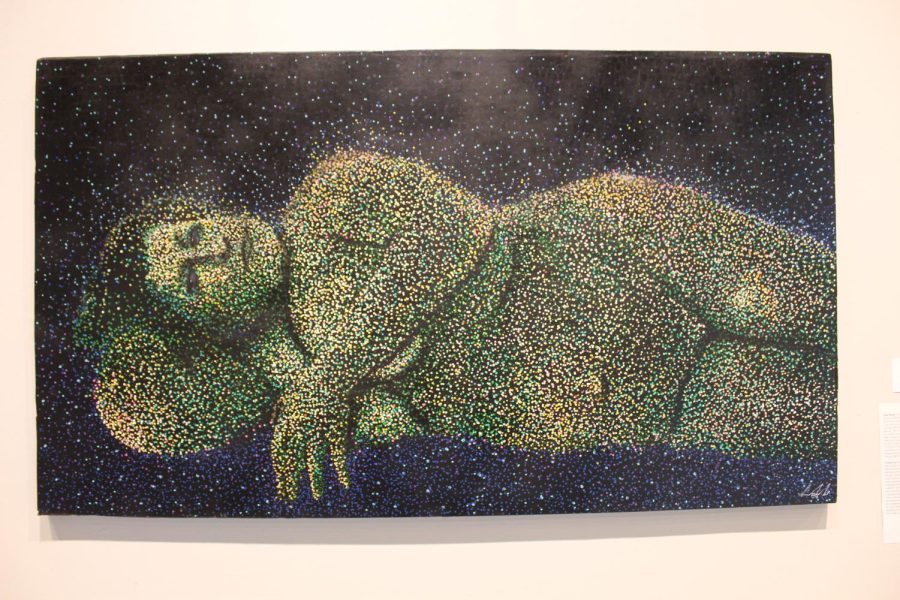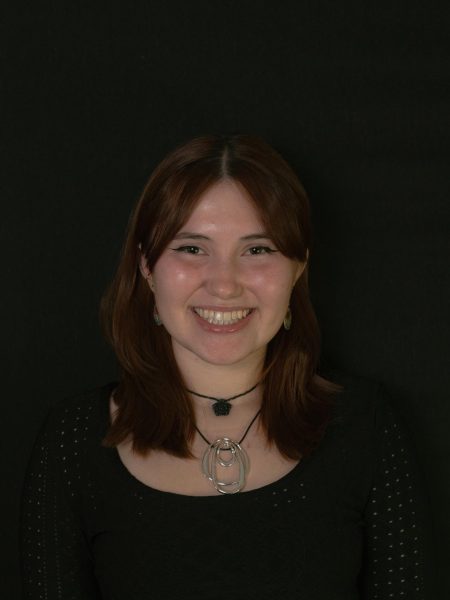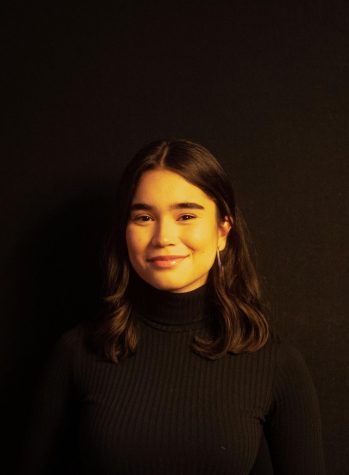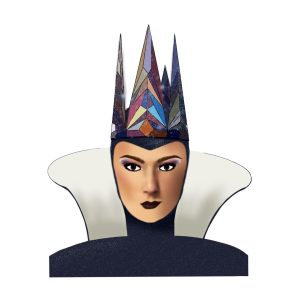Centro Cultural Aztlan hosts “Mars Needs More Women: Project MASA-V”
Local exhibition explores Chicanx and Latinx Futurism to portray greater messages of life and identity
Sam Rawls. “Viridescent Self.”
April 26, 2022
“Mars Needs More Women: Project: MASA-V” is the fifth installation of a years-long collaborative exhibition as a part of a larger series. Project: MASA, which gathers Chicanx artists using science fiction and outer space iconography, drawing from the past, present and future in order to comment on social issues. The project was first created by artist and arts educator Luis Valderasin in the early 2000s.
“I’ve been working on this for almost 20 years now…organizing this required extremely open lines of communication with ALL the participants in order to materialize this vision,” Valderas remarked.
“Mars Needs More Women” explores the science fiction genre through the lens of Chicanx and Latinx perspectives. Although science fiction is an immensely popular genre, there is barely any legitimate Latinx representation within its stories. Therefore, “Mars Needs More Women” strives to explore “Chicanx/Latinx Futurism.”
“Chican@ Futurism is our gente’s (people’s) way of decolonizing and gaining agency by recreating our own realities through the use of tropes that bridge time and speculative realities,” Valderas explained.
The exhibition is located in the historic Centro Cultural Aztlan; it was established in 1977 by a group of young Chicanx activists with the goal of extending their message of pride and empowerment to the San Antonio community. Even after its retirement from use by political activists, the Centro Cultural Aztlan has continuously served as a platform for promoting and uplifting Chicanx and Indigenous culture. Through exhibits such as “Mars Needs More Women,” they work to support artistic creativity, especially among local and emerging artists. The exhibition curated by Cathryn Merla-Watson, Ph.D. and Iliana Pompa features the work of 19 different Chicanx and Latinx artists from San Antonio and across the larger South Texas area. Artists whose works were displayed include: Catherine Cisneros, Celeste De Luna, Yareth Fernandez, Brandy González, Suzy Gonzalez, Nansi Guevara, Mari Hernandez, Terry Ybañez, Lizette Ortiz, Pocha Peña, Sam Rawls, Natalia Rocafuerte, Mary Agnes Rodriguez, Ana Lilia Salinas, Liliana Wilson, Cindy Valderas and Guillermina Zabala.
The exhibition is made up of many different types of artworks, including paintings, drawings, prints, sculptures and mixed media pieces.
Guillermina Zabala is an Argentinian interdisciplinary artist that primarily works with photography, film, prints and other forms of mixed media. Her print series titled, “Lukutuwe I-III” is Zabala’s way of returning to her roots. The symbolism of her piece stems from those created by the Mapuche people, an indigenous group that resides in different parts of South America, primarily Chile and parts of Argentina. Using Mapuche imagery, she wished to reconnect with her Argentinian roots and explore ideas of gender fluidity whilst educating herself on Mapuche culture.
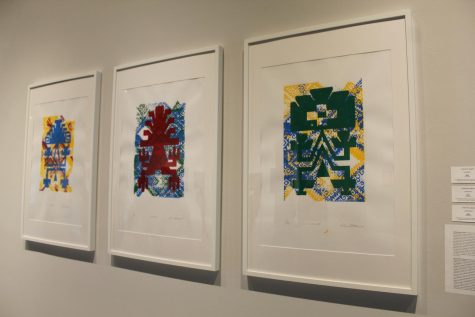
“Lukutuwe is an image that represents a person; it doesn’t have to be a woman or a man, so it’s a kind of gender-neutral person. [The symbol portrays a person] looking up to the sky in a kneeling position. And for the Mapuche tribe, it’s really an important figure. They use it a lot in a variety of different rituals and their own textile work. And so I read more about it and I felt like the word connected with the idea behind Lukutuwe. One because, you know, I wanted to do something that represents this gender fluidity approach and something where it’s like [includes] the indigenous’ kind of cosmovision and the idea of how indigenous tribes see our universe,” Zabala explained.
Among the featured artists is popular local artist Brandy González, whose work has been featured numerous times in San
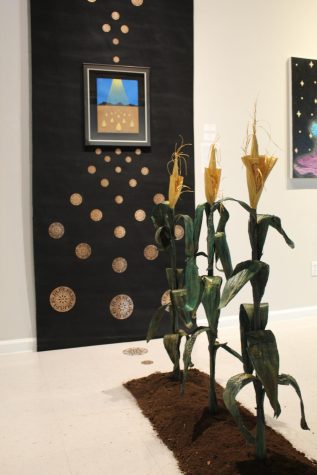
Antonio, including in the reopening of the Centro De Artes Gallery. The “Mars Needs More Women” exhibit features two of her pieces titled “They Did Not Know We Were Seeds” and “We’ve Been Here.” The pieces coincide to portray a bigger statement of rebirth, culture and gender expression. “They Did Not Know We Were Seeds” plays off of the Mexican proverb, “They tried to bury us. They did not know we were seeds.” Made with hojas (tamale leaves) and paint, this piece plays in with its counterpart “We’ve Been Here,” which explores how our ancestors’ knowledge is reborn and projected through spacetime to continue to grow across distant lands. The pieces work to depict stronger messages of resilience and strength exhibited by people of Chicanx/Latinx heritage.
“What if our ancestors would redeem us with the ancestral knowledge that has been whitewashed or taken away from us? And that has come back so once they give us the energy that we’re able to spread that through the cosmos is as represented through this void of space-time. And then we’re able to give birth again, growing in some of the harshest conditions that we have here. So you can see some of the little babies or the little center there… The Day of the Dead kind of representing our ancestors coming back out, growing into the plants so intricate and detailed.” González remarks.
“Mars Needs More Women” emphasizes the importance of representation and perseverance of Chicanx and Latinx culture in an ever-evolving society. Through the artists’ usage of science fiction iconography, the stories and culture are declared through multi-medium works of art and how they intersect with our past, present and future roots. “Mars Needs More Women” and Centro Cultural Aztlan is partly funded by the city but they receive significantly less marketing and advertising than other exhibitions in San Antonio. Now more than ever, the need to support these emerging and local artists is prevalent. Promoting local artists is a necessary step toward keeping art and culture alive in San Antonio. “Mars Needs More Women: Project MASA-V” is currently on view at the Centro Cultural Aztlan in the Deco District, San Antonio. It is completely free to the public and is on display Monday-Thursday, 10:00 a.m. to 4:00 p.m through June 10, 2022. For more information about the exhibit, click here or visit Centro Cultural Aztlan website.


